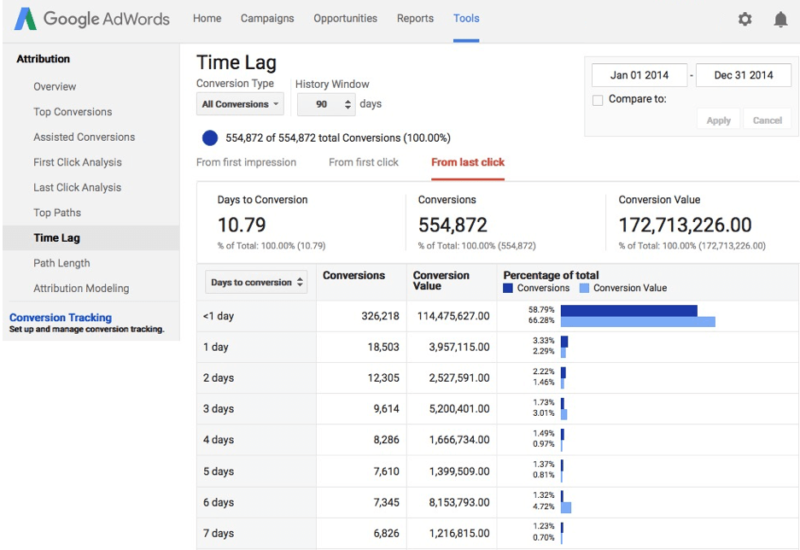How PPC Advertisers Can Best Leverage The Research Period This Holiday Season
Columnist Benjamin Vigneron shares thoughts and data on how to pace your search marketing budget over the course of the holiday season.
Many advertisers will be looking into their historical daily or weekly online revenue numbers in order to come up with their online flighting strategy for this coming holiday season.
While that’s a good start, you want to make sure that when leveraging historical revenue data, you are taking into account the lag from click/impression to sale. Essentially, you want to build quality traffic for the Thanksgiving weekend, as opposed to spending a lot more than usual just on those days.
Here are a few thoughts on how can you can make this happen and the potential lift you can expect from better pacing your budget over the course of the holiday season.
1. Account For The Lag From Impression/Click To Online Sale
If you’re using AdWords as your primary source of truth, then you’re only capturing transaction date online revenue. The revenue numbers are associated with the days when those transactions occurred, as opposed to when the original impressions or clicks leading to those transactions occurred.
It might not be a big deal if most transactions occur within the first 24 days following an ad impression or click; however, in most cases, this lag is likely to be significant enough for you to adjust your online flighting strategy accordingly. And the revenue lift from better pacing your budget over the course of the quarter can be massive.
The example below shows daily transaction date vs. click date during last year’s holiday season for a major US retailer across their paid search and shopping campaigns. Comparing both trends shows that there are times when transaction date revenue is greater than click date revenue, and conversely, some other times click date revenue is greater.
The pre-Black-Friday weekend research period is often characterized by lower transaction date revenue because consumers are holding off on their purchases, while click date revenue is actually pretty high during that research time, since those impressions and clicks are having a strong influence on later transactions. This is precisely what we are trying to capture here.
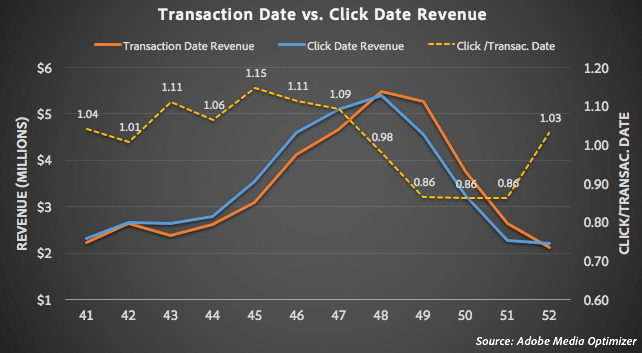
The research period (from 43 to 47) can be identified by higher click date revenue, while the decision period (from 48 to 51) is characterized by higher transaction date revenue.
In practice, either the technology you use (such as Adobe Media Optimizer) offers impression/click date reporting, or you can still delve into AdWords’ time lag analysis in Tools > Attribution > Time Lag.
Note that this lag may vary over time. From my experience, it tends to decrease during promotion periods and increase the rest of the year. In the example below, you can see how the time lag from last click to transaction varied over time last year.
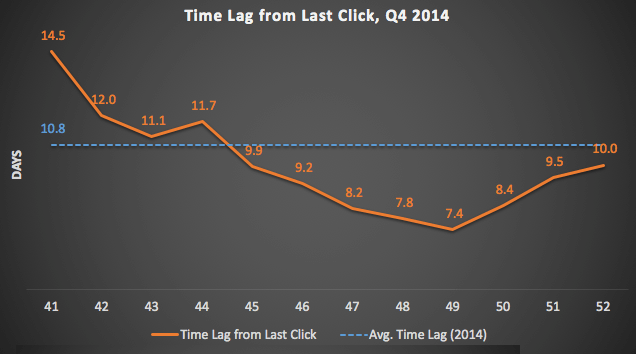
While the average lag from last click to transaction was 10.8 days in 2014, the lag was longer in October, then much shorter in November, especially during weeks 48 (Black Friday) and 49 (Cyber Monday).
2. Adjust Your Flighting Strategy Accordingly
Whatever your methodology for putting together a forecast, you might want to compare your predictions if using transaction date vs. click date revenue. In my case, I estimated the optimal online flighting based on historical efficiency (that is, the ROAS, or return on ad spend) where we’d want spend less whenever the ROAS is expected to be lower than average, and more whenever the ROAS is expected to be higher than average.
More specifically, you can build predictive yield curves to determine future optimal spend targets based on the predicted elasticity between ad spend and revenue, as explained in a previous post.
The outcome of this analysis is that you would naturally want to invest more during the research period, now that you are better attributing online revenue to the original impressions and clicks that lead to this revenue.
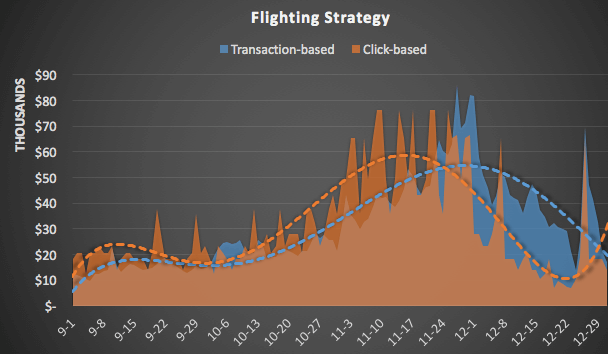
Looking at click-date revenue, we’d want to invest more during the research period (mid-October through end of November), now that we are attributing revenue to the original impressions and clicks which lead to those transactions.
Another way to look at this is to compare your share of budget going to a specific month:
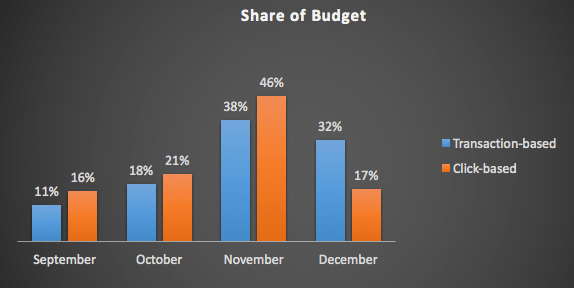
In this particular case, my optimal September budget should be 11% of my budget for the whole period (Sept. to Dec.) if using transaction date revenue, as opposed to 16% if using click date revenue. October, November and December would get 18%, 38%, and 32% if using transaction date revenue as opposed to 21%, 46% and 17% if using click date revenue. Essentially, we should move a significant chunk of the December budget to October and November.
As you can see, the budget shift from December to October and November can be significant. More importantly, when running the numbers for this particular advertiser, the expected revenue lift would be +11 percent simply by pacing the same amount of money in a smarter way through the holiday season — that is, by building quality traffic during the research period.
In a nutshell, online marketers should definitely move away from transaction date reporting and instead value impression/click date revenue reporting capabilities for the online initiatives. Better attributing revenue over time can unlock significant growth opportunities.
Opinions expressed in this article are those of the guest author and not necessarily Search Engine Land. Staff authors are listed here.
Related stories

